Explainer
- Explainer
- The future fix
The numbers don’t lie so why aren’t we doing more to halt climate change?
In the third part of The Future Fix, we examine the "far away" threat of climate change. The science is unequivocal. So why are our politicians so resistant to taking real action? And what about us?
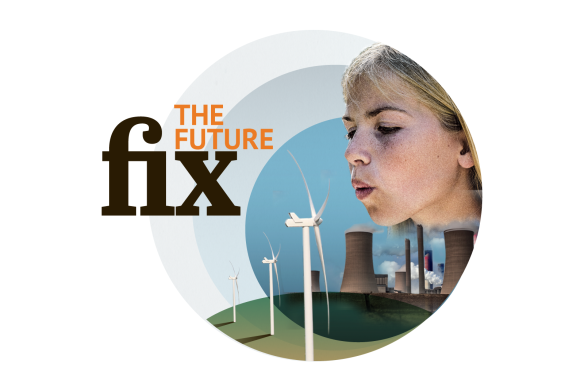
Credit: Matthew Absalom-Wong
Even veteran scientists hardened by decades of climate scepticism could hardly believe their ears. Environment Minister Melissa Price, responding to a bombshell report that distilled 6000 scientific papers, said the experts had it wrong.
Phasing out coal within three decades to avert calamitous global warming? That was “drawing a long bow”, Price said of the recommendation by the United Nations' Intergovernmental Panel on Climate Change (IPCC).
Sure, the experts predict food shortages, lost livelihoods and stunted economies. Cyclones and droughts will hit with frightening regularity. Bleaching will annihilate the Great Barrier Reef.
But Price made “no apology” for her government’s decision to dump efforts to cut pollution from electricity generation. Lower power bills were more important. And after all, she said, Australia is just a tiny contributor to global emissions.
Around the country, scientists wrung their hands in despair. World-renowned reef biologist Ove Hoegh-Guldberg was, to put it mildly, “disappointed”.
“The numbers don’t lie. It’s very clear we have to phase out fossil fuels by mid-century,” he said.
“We need a leadership that embraces the future and sets us on a new course.”
The naturalist Sir David Attenborough reinforced the message this week when he told the UN climate summit in Poland that “if we don’t take action, the collapse of our civilisations and the extinction of much of the natural world is on the horizon”.
For at least two decades, scientific evidence on climate change has been unequivocal. By burning fossil fuels on a massive scale, humans have changed the climate system. And after years of torpor, we have left ourselves only a short window of time to avoid damage on a cataclysmic scale.
Australia, already the world’s driest inhabited continent, is uniquely vulnerable. And yet real action here, as in much of the world, is elusive.
In fact, on current trajectories Australia, and the world, is heading in the wrong direction. The International Energy Agency says last year’s emissions from energy alone – coal, gas, oil, renewables and nuclear – rose 1.4 per cent to a historic high of 32.5 gigatonnes. This is the equivalent of adding 170 million cars to the road. The agency expects that emissions in 2018 will be higher still. Official data shows that Australia’s annual carbon emissions climbed for the fourth year running in the year to June 2017 – up by 0.7 per cent to 550 million tonnes.
The recent release of Labor’s climate change action policy for electricity, and the looming federal election, have thrust the issue to the political forefront once more.
So where does Australia sit on climate action? Where are we winning, what is holding us back, and what can we all do to help get truly serious about cutting our greenhouse gas emissions?
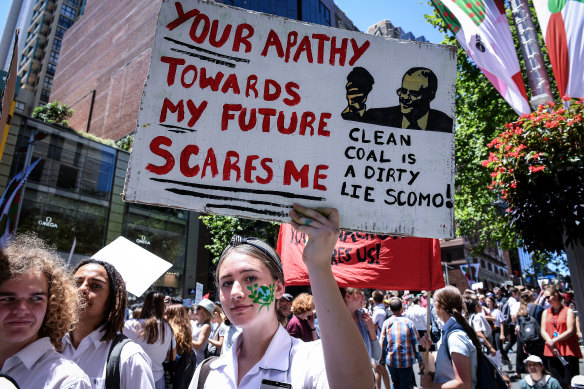
Saskia Cook-Knowles of Port Kembla High School was one of thousands of students demanding action on climate change in November.Credit: AP
Opinion polls show most Australians accept that climate change is happening, that humans have caused it and that they want action. It certainly emerged as a hotly contested issue in the Wentworth by-election in October, with winning candidate Kerryn Phelps advocating stronger action. But that doesn’t mean everyone is frantically cutting their carbon footprint and lobbying leaders for policy change. People do not always respond to existential threats in rational ways.
The Australian Psychological Society’s Susie Burke says humans tend to distance themselves from daunting problems, and see climate change as something happening to someone else, in a faraway place.
“Many people ... might not be feeling the impact here and now. We tend to discount problems we think are far away in time or place, we are more likely to respond to threats that are close to us,” Dr Burke said.
“Our brain is relatively unchanged from a time when survival was based on [attending to] an imminent threat. It’s not a particularly well-suited mechanism for huge threats like climate change.”
The residents of the world’s lowest-lying nations, such as Kiribati, may be less sanguine. So too are many younger Australians, who will be more exposed to the consequences – thousands of them went on strike from school in November to protest at government inaction.
Other people may just feel guilty about contributing to the problem, or for failing to act. They may distract themselves, or concentrate on other demands for their energy – family, health, money, job security and “what we are going to eat for dinner”, she says.
Only a tiny proportion of people truly deny the scientific reality of climate change. But this vocal and sometimes rich and powerful group – including corporations with fossil-fuel interests – can muddy the public debate with misinformation.
“Whenever people perceive there might be some uncertainty about something, it tends to have a slowing effect on people’s preparedness to do something urgent,” Dr Burke says.
Psychologists say a lack of knowledge, social pressure to consume, financial constraints and a resistance to changing our world view can also play a role in preventing climate action.
Some citizens may mistrust scientists or politicians. And in other cases, people might make a relatively minor effort to help the environment, such as recycling, and decide they are off the hook for more dramatic changes in their lifestyle.
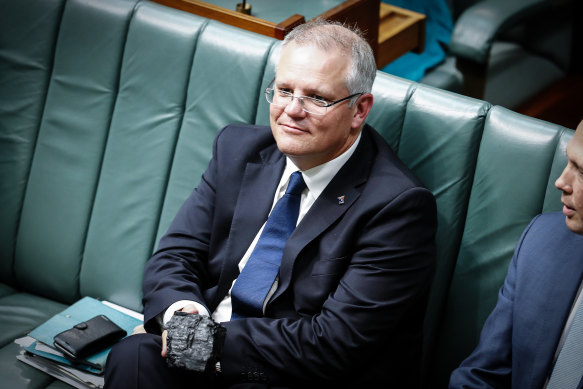
Then-treasurer Scott Morrison brought coal to Parliament in 2017 to show Coalition support for mining the fossil fuel.Credit: Alex Ellinghausen
Market forces and technology are already pushing Australia’s electricity mix from coal to renewables, which made up about 17 per cent of the electricity mix last year and which are growing exponentially. Individuals and communities are working at the grassroots to cut emissions. But for Australia, and the world, to make the drastic transition outlined by the IPCC, governments must be willing to pull policy levers.
Unfortunately for Australia, more than a decade of so-called “climate wars” has left a policy paralysis. Driven by short-term interests, power struggles, politicking and blind ideology, the nation’s leaders have fought over and dumped a raft of promising emissions-curbing measures.
The Coalition’s National Energy Guarantee aimed to reduce emissions while providing a reliable mix of renewables, coal and gas. While heavily criticised for its lack of emissions ambition, it offered a solid policy framework upon which more progressive future governments could build.
The real political obstacle is 'culture war stuff’.
The plan was consigned to landfill in August after climate-sceptic MPs on the government’s backbench rallied against it, saying it would harm the economy, kill the coal industry and fail to rein in prices.
The MPs apparently overlooked the colossal costs of not acting on climate change and the benefits to be gained by decarbonising the economy.
Academic and former Climate Change Authority board member John Quiggin says the falling cost of renewables also renders the Coalition’s economic-harm argument irrelevant.
The real political obstacle, Quiggin says, is “culture war stuff”.
“It’s become part of people’s political identity ... So in that context there is very little point in presenting [denialists] with charts and graphs and scientific reports,” he says.
“[They] don’t want to do anything, they don’t like environmentalists and are therefore choosing to either deny the climate science or put forward some other spurious reason for doing nothing.”
The powerful influence of fossil fuel companies has also been blamed for climate inaction in politics. The industry makes generous donations to political parties, and a revolving door between major political parties and coal and gas companies – Prime Minister Scott Morrison’s chief of staff John Kunkel is a former Minerals Council of Australia executive – means coal lobbyists know how the system works and have the ear of many a politician.
The Greens say political parties are too reliant on fossil fuel money, and the donations must be banned if Australia is to shift to a clean economy. At the very least, the Greens argue, donations should be made public before elections, not afterwards.
Quiggin says Australia’s best hope for climate progress is a Labor government elected for at least two terms, giving it a chance to implement its policy of a 45 per cent emissions cut across the economy. (Labor, which is currently leading in the polls, said in November that it would seek to revive the National Energy Guarantee but with a much higher emissions reduction goal of 45 per cent by 2030, based on 2005 levels.)
In the meantime, the Coalition might realise that climate inaction is “a losing issue” with voters, Quiggin says.
If politics is holding back real progress on climate change, then the media must take some responsibility. In Australia, it’s the political debate around climate policy that tends to dominate mainstream news coverage, notes the University of Sydney’s Benedetta Brevini. She says that compared with Europe, some Australian news outlets also give far more oxygen to the climate-sceptic agenda.
Mainstream coverage of climate change is also usually episodic and event-driven, focusing on natural disasters or the release of major climate reports rather than delivering “a long-term discussion [in which] you can keep informing the public slowly but constantly”.
“That is not great for explaining to the public what [climate change] actually means, the impact on the environment and giving voice to scientists,” she says.
She thinks the media should tell positive stories of people, communities and governments making a difference.
“The idea is to give people hope that [the problem] can be controlled ... that there is still room for adaptation and mitigation.”
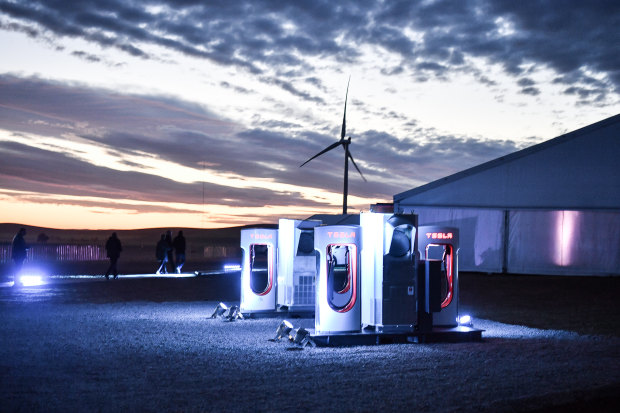
A car-charging station at Tesla's wind and solar battery plant outside of Jamestown, South Australia.Credit: AAP
As the transition from coal and gas to renewable energy gathers pace, storing electricity and connecting it to the grid so it can be delivered on demand is the next challenge.
Australia is on the cusp of an energy storage boom, says the Climate Council, as states invest in grid-scale battery storage, including Tesla’s huge lithium-ion battery in South Australia. The federal government’s Snowy 2.0 pumped hydro expansion – effectively, a giant battery – also promises to firm up the intermittent power generated by wind and solar.
Other technologies show promise but need work. The Australian Renewable Energy Agency is exploring tidal energy. The national science agency CSIRO says wave (as in, ocean) energy could contribute up to 11 per cent of Australia’s energy – enough to power Melbourne. Geoscience Australia says geothermal energy, leveraging the heat that occurs naturally in the Earth, has “significant potential”.
The federal government’s top scientist, Alan Finkel, says Australia could slash global carbon emissions and create a multibillion-dollar export industry by developing hydrogen to replace fossil fuels.
The transition has its challenges. Nuclear power, for example, has struggled to win over the community on environmental and ethical grounds. And even when clean-energy technology works, producing it at scale is not always economical.
The number of electric cars on Australian roads has increased by 160 per cent in the past five years, but that is well behind much of the developed world.
Australia’s reliance on road transport is another big issue: it’s one of the reasons our per capita emissions are higher than those of most other countries. Road, rail and domestic aviation and shipping are our second-largest sources of greenhouse gas pollution after electricity production, says the Climate Council. It is also the fastest-growing source of emissions, climbing 62.9 per cent since 1990.
The number of electric cars on Australian roads has increased by 160 per cent in the past five years, but that is well behind much of the developed world.
France and Britain will end the sale of new diesel and petrol cars by 2040, and Norway and the Netherlands aim to do so by 2025. Policies such as these obviously fast-track the electric vehicle revolution but the government has shown no signs of replicating them.
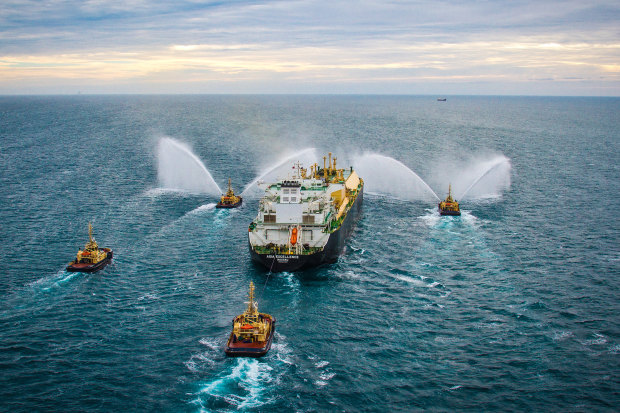
The first LNG cargo leaving Chevron's Gorgon project in WA. Credit: Bloomberg
There’s a twist too: the IPCC says that, to meet the 1.5-degree warming limit, nations not only have to slash emissions but actively remove greenhouse pollution from the air using so-called negative emissions technologies. For now, these methods are mostly unproven at scale.
Carbon capture and storage involves trapping greenhouse gases at the point of emission, such as at a coal plant, then storing it, often underground in geological formations. Globally, fewer than 20 large-scale projects use it.
The most advanced domestic venture is at Chevron's Gorgon natural gas project in Western Australia – a huge carbon polluter – which aims to capture carbon dioxide from a gas field and inject it into undersea storage. But the injection has been delayed due to technical issues for almost two years.
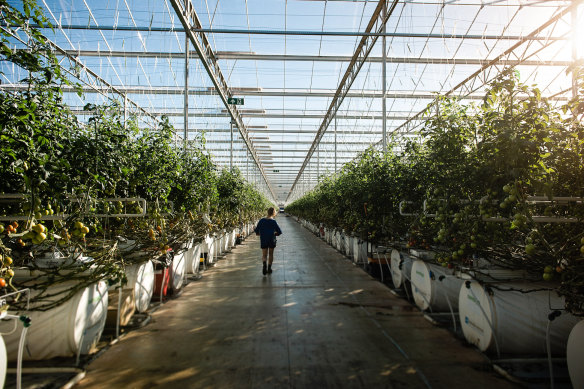
Sundrop tomato farm in Port Augusta uses solar power and desalinated water.
Meanwhile, on a patch of dry red earth at Port Augusta, a revolution is quietly growing. From the South Australian desert sprout juicy red tomatoes, watered and nurtured by the power of the sun.
There is no fresh water here and the heat can be merciless. But Sundrop Farms has shown that, with the right technology and a dose of belief, humans can find ways to live and eat without hurting the planet.
“What we are doing is really innovative not only in Australian terms but international terms,” says chief executive Steve Marafiote.
You can use solar or other solutions that can help reduce your operating expenses … but also deliver an environmental impact.
Conceived a decade ago, the hydroponic operation runs mostly on solar thermal power. A field of 24,000 mirrors beam energy to a 127-metre-high tower. The resulting energy heats a huge reservoir of water that warms and cools vast greenhouses. The energy also turns seawater pumped from the nearby Spencer Gulf into freshwater via an onsite desalination plant.
Sundrop Farms delivers up to 17,000 tonnes of truss tomatoes each year to supermarkets – about 15 per cent of Australian supply.
Marafiote says the project, which has a tiny carbon footprint, proves the benefits of “thinking about things differently”.
“You can use solar or other solutions that can help reduce your operating expenses … but also deliver an environmental impact,” he says.
The Sundrop tomato farm is just one example of enterprising people successfully tackling climate change in Australia – and without a major disruption to our way of life. “It resonates incredibly well with consumers,” says Marafiote. “They are eating produce at its best.”
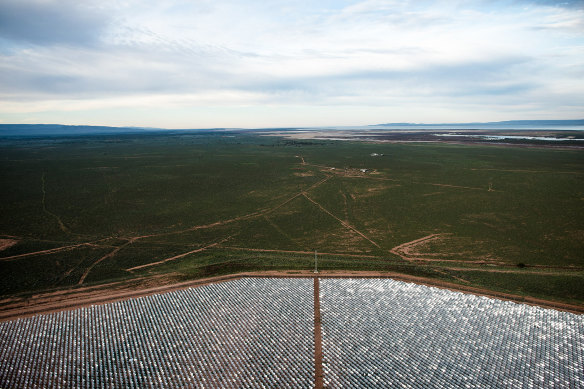
The 20-hectare Sundrop farm uses solar power and desalinated water from the Spencer Gulf.
Let us explain
If you'd like some expert background on an issue or a news event, drop us a line at explainers@smh.com.au or explainers@theage.com.au. Read more explainers here.